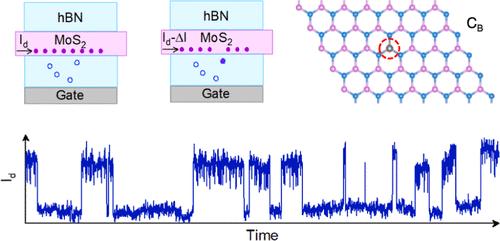Characterizing Defects Inside Hexagonal Boron Nitride Using Random Telegraph Signals in van der Waals 2D Transistors
IF 15.8
1区 材料科学
Q1 CHEMISTRY, MULTIDISCIPLINARY
引用次数: 0
Abstract
Single-crystal hexagonal boron nitride (hBN) is used extensively in many two-dimensional electronic and quantum devices, where defects significantly impact performance. Therefore, characterizing and engineering hBN defects are crucial for advancing these technologies. Here, we examine the capture and emission dynamics of defects in hBN by utilizing low-frequency noise (LFN) spectroscopy in hBN-encapsulated and graphene-contacted MoS2 field-effect transistors (FETs). The low disorder of this heterostructure allows the detection of random telegraph signals (RTS) in large device dimensions of 100 μm2 at cryogenic temperatures. Analysis of gate bias- and temperature-dependent LFN data indicates that RTS originates from a single trap species within hBN. By performing multispace density functional theory (MS-DFT) calculations on a gated defective hBN/MoS2 heterostructure model, we assign substitutional carbon atoms in boron sites as the atomistic origin of RTS. This study demonstrates the utility of LFN spectroscopy combined with MS-DFT analysis on a low-disorder all-vdW FET as a powerful means for characterizing the atomistic defects in single-crystal hBN.

利用范德华二维晶体管中的随机电报信号表征六方氮化硼内部缺陷
单晶六方氮化硼(hBN)被广泛应用于许多二维电子和量子设备中,其缺陷对设备性能有重大影响。因此,六方氮化硼缺陷的表征和工程设计对于推动这些技术的发展至关重要。在此,我们利用低频噪声 (LFN) 光谱法,在封装 hBN 和石墨烯接触 MoS2 场效应晶体管 (FET) 中研究了 hBN 中缺陷的捕获和发射动力学。这种异质结构的低无序性允许在低温条件下以 100 μm2 的大器件尺寸检测随机电报信号 (RTS)。对栅极偏压和随温度变化的 LFN 数据的分析表明,RTS 源自 hBN 中的单一陷阱物种。通过对栅极缺陷 hBN/MoS2 异质结构模型进行多空间密度泛函理论 (MS-DFT) 计算,我们认为硼位点中的置换碳原子是 RTS 的原子起源。这项研究证明了 LFN 光谱与 MS-DFT 分析相结合在低失序全 VdW FET 上的实用性,是表征单晶 hBN 中原子缺陷的有力手段。
本文章由计算机程序翻译,如有差异,请以英文原文为准。
求助全文
约1分钟内获得全文
求助全文
来源期刊

ACS Nano
工程技术-材料科学:综合
CiteScore
26.00
自引率
4.10%
发文量
1627
审稿时长
1.7 months
期刊介绍:
ACS Nano, published monthly, serves as an international forum for comprehensive articles on nanoscience and nanotechnology research at the intersections of chemistry, biology, materials science, physics, and engineering. The journal fosters communication among scientists in these communities, facilitating collaboration, new research opportunities, and advancements through discoveries. ACS Nano covers synthesis, assembly, characterization, theory, and simulation of nanostructures, nanobiotechnology, nanofabrication, methods and tools for nanoscience and nanotechnology, and self- and directed-assembly. Alongside original research articles, it offers thorough reviews, perspectives on cutting-edge research, and discussions envisioning the future of nanoscience and nanotechnology.
 求助内容:
求助内容: 应助结果提醒方式:
应助结果提醒方式:


